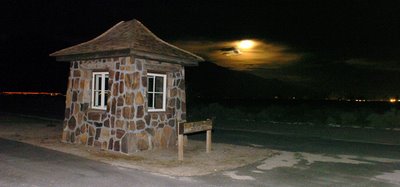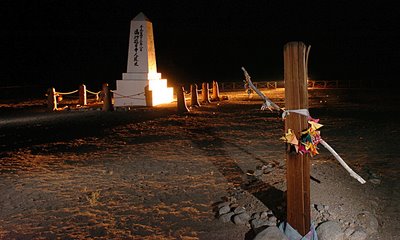 This is the Military Police station at the Manzanar War Relocation Center.
This is the Military Police station at the Manzanar War Relocation Center.It is now a National Historic Site located at Independence, Calif., in the Owens valley near the Inyo range of the Sierra Nevada mountains.
Manzanar was one of ten locations where American citizens of Japanese descent were interred during World War II. At its peak population of 10,046, mostly Californians from Los Angeles were held till the last was released on November 25, 1945. One hundred seventy-four men and women joined the United States Military service directly from the camp.
 It is now populated only by desert wildlife like this Kangaroo Mouse.
It is now populated only by desert wildlife like this Kangaroo Mouse.  This is the cemetery at the Manzanar War Relocation Center.
This is the cemetery at the Manzanar War Relocation Center.The inscription, seen here, is on the back of the obelisk and reads, "Erected by the Manzanar Japanese August 1943." On the front translates as, "Monument to console the souls of the dead."
Ansel Adams visited and photographed Manzanar in the fall of 1943, then wrote a book; Born Free and Equal: the story of loyal Japanese Americans. In his introduction he penned:
“…I trust the content and message of this book will suggest that the broad concepts of American citizenship, and of liberal democratic life the world over, must be protected in the prosecution of the war and sustained in the building of peace to come.”
In the chapter, “The Problem,” Adams wrote about what was going to happen after the war with regards to residual antagonisms and, “The spirits of Jim Crow walks in almost every section of our land…” He continued, “ Hatred is a perfectly natural complement to fear and to the war spirit; and it is difficult to assure otherwise solid and sincere people that ancestral relations to the enemy does not prove disloyalty.” Finally Adams noted, “The fatal phrase, ’A Jap’s a Jap’, might well have poisoned the course of racial tolerance for many years to come.”
Adams was a sage man and an inspirational photographer.
 This is University of New Mexico Art and Art History Department’s Regent's Professor of Photography Patrick Nagatani at a 2001 Santa Fe opening of his one-man show. As a graduate student at the University of California, Los Angeles, in 1978, he and two fellow students were curators of an exhibit: Two Views of Manzanar by Ansel Adams and Toyo Miyatake, at the Frederick S. Wight Art Gallery.
This is University of New Mexico Art and Art History Department’s Regent's Professor of Photography Patrick Nagatani at a 2001 Santa Fe opening of his one-man show. As a graduate student at the University of California, Los Angeles, in 1978, he and two fellow students were curators of an exhibit: Two Views of Manzanar by Ansel Adams and Toyo Miyatake, at the Frederick S. Wight Art Gallery. Miyatake was a camp resident who had been a Los Angeles artist and photographer. Adams smuggled him a lens, film holders and film. Miyatake photographed Manzanar with his contraband camera until it was discovered and confiscated. The camp’s commander made Miyatake the “official photographer.”
So, what's wrong with this picture?
President George W. Bush made remarks upon arriving at the Green Bay, Wisconsin Austin Straubel International Airport, today. Talking about Great Britain’s foiling of terrorists plot to destroy airliners. Bush said that it was, "a stark reminder that this nation is at war with Islamic fascist who will use any means to destroy those of us who love freedom, to hurt our nation."
Bush angered American Muslims by his inflammatory rhetoric, lumping the terror actions of individuals as fascists and applying it to an entire religion.
The Muslims are rightfully fearful that just because they practice a faith, they are presumed to be fascist.
Adams was right. It would be wrong for all Americans to be lumped together for the violent act of, say the Ku Klux Klan, American Nazi Party or the Skinheads.
Condemn the individual, root them out if you can and destroy them!
I have always believed that when you declare war on a societal ill or on an idea, you have already lost the war because the war mentality overlooks the complexities of the problem and tries to simply destroy anything that looks like, smells like, sounds like… the problem.
Think about how this started. President Lyndon Baines Johnson declared a war on poverty; President Richard M. Nixon, a war on crime; President Ronald Reagan, a war on drugs; and now Bush’s war on terror. None have succeeded; we still have poverty, crime, drugs, and terror with no victory in sight for any of them.
No comments:
Post a Comment